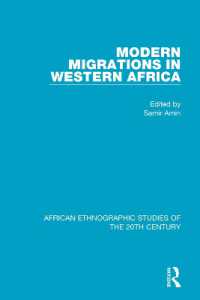- ホーム
- > 洋書
- > 英文書
- > Science / Mathematics
Full Description
Systems approaches for agricultural development are needed to determine rational strategies for the role of agriculture in national development. Mathematical models and computer simulation provide objective tools for applying science to determine and evaluate options for resource management at field, farm and regional scales. However, these tools would not be fully utilizable without incorporating social and economic dimensions into their application.
The second international symposium, Systems Approaches for Agricultural Development (SAAD), held in Los Baños, 6-8 December 1995, fostered this link between the biophysical sciences and the social sciences in the selection of keynote papers and oral presentations, a selection of which are included in these books. The contents further reflect how systems approaches have definitely moved beyond the research mode into the application mode. The large number and high quality of interdisciplinary research projects reported from different parts of the globe, to determine land use options that will meet multiple goals and yet sustain natural resource bases, is a key indicator of this `coming of age'. At the farm level, where trade-off decisions between processes and products (commodities) feature strongly, much progress is also evident in the development of systems-based tools for decision making. At the field level optimization of resource use and minimizing environmental effects has become of major concern for which systems approaches are indispensable.
The books, of which Volume I deals with regional and farm studies level and Volume II with field level studies, will be of particular interest to all agricultural scientists and planners, as well as students interested in multidisciplinary and holistic approaches to agricultural development.
Contents
Preface. The Challenge of Integrating Systems Approach in Plant Breeding: Opportunities, Accomplishments, and Limitations; P.K. Aggarwal, et al. Using Systems Approaches for Targeting Site Specific Management on Field Level; J. Bouma, et al. New High-Yielding, Weed Competitive Rice Plant Types Drawing from O. sativa and O. glaberrima Genepools; M. Dingkuhn, et al. Improving Rice Tolerance to Barnyardgrass through Early Crop Vigour: Simulations with INTERCOM; J.L. Lindquist, M.J. Kropff. Recent Advances in Breeding for Drought Tolerance in Maize; G.O. Edmeades, et al. Potential Yield of Irrigated Rice in African Arid Environments; M. Dingkuhn, A. Sow. Assessing the Potential Yield of Tropical Crops: Role of Field Experimentation and Simulation; R.C. Muchow, M.J. Kropff. Evaluation of the CROPGRO-Soybean Model over a Wide Range of Experiments; K.J. Boote, et al. Adaptation of the CROPGRO Model to Simulate the Growth of Field-Grown Tomato; J.M.S. Scholberg, et al. A Modified Version of CERES to Predict the Impact of Soil Water Excess on Maize Crop Growth and Development; J.I. Kizaso, J.T. Ritchie. Mitigating Climate Change Effects on Rice Yield; S. Mohandass, T.B. Ranganathan. Competition for Light in Windbreak-Millet Systems in the Sahel; M. Mayus, et al. Crop Models and Precision Agriculture; M.Y.L. Boone, et al. A Conceptual Model for Sodium Uptake and Distribution in Irrigated Rice; F. Asch, et al. Using Decision Support Systems to Optimize Barley Management on Spatial Variable Soil; H.W.G. Booltink, J. Verhagen. Application of SOYGRO in Argentina; S. Meira, E. Guevara. Modeling the Effect of Nitrogen on Rice Growth and Development; T. Hasegawa, T. Horie. Optimization of Nitrogen Fertilizer Application to Irrigated Rice; R.N. Dash, et al. Simulating Rice Leaf Area Development and Dry Matter Production in Relation to Plant N and Weather; M. Ohnishi, et al. Influence of Split Application of Nitrogen on Foliar N Content, Photosynthesis, Dry Matter Production and Yield in Short and Medium Duration Rice Cultivars; C. Vijayalakshmi, M. Nagarajan. Systems Approaches to Improve Nitrogen Management in Rice; B. Mishra. Use of Simulation Models to Optimize Fungicide Use for Managing Tropical Rice Blast Disease; S.B. Calvero, P.S. Teng. Yield Gap Analysis of Rainfed Lowland Systems to Guide Rice Crop and Pest Management; H.O. Pinnschmidt, et al. Quantification of the Effects of Bacterial Blight Disease on Rice Crop Growth and Grain Yield; P.R. Reddy. Better Biological Control by a Combination of Experimentation and Modelling; J.C. Van Lenteren, H.W.J. Van Roermund. Quantitative Evaluation of Growth and Yield of Rice Plants Infested with Rice Planthoppers; T. Watanabe, et al. Addressing Sustainability of Rice&endash;Wheat Systems: Analysis of Long-Term Experimentation and Simulation; J. Timsina, et al. Systems Approach in the Design of Soil and Water Conservation Measures; L. Stroosnijder, P. Kiepe. Farming Systems for Sustainable Agriculture and Environmental Quality; R.S. Kanwar, et al. Harnessing Crop Research Data to Develop Expert Systems; K. Muralidharan, E.A. Siddiq. Comparison of Predictions and Observations to Assess Model Performance: A Method of Empirical Validation; P.L. Mitchell, J.E. Sheehy. Acronyms. Subject Index.








